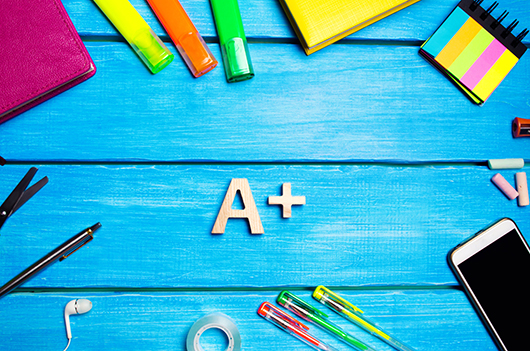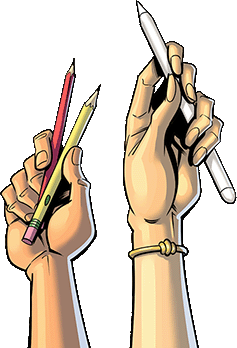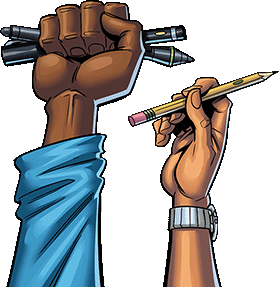How a Comic Book Format Can Help Dyslexic Learning
December 17, 2020
Comic books are helpful educational tools, especially for those with non-typical learning styles. Comics and graphic novels are used in the classroom to supplement traditional texts, engage reluctant readers, and offer students with Dyslexia a more accessible reading experience. The reason that these types of materials help dyslexic learning is due to the comic book format.
Comic books feature short bursts of text, descriptive one-word exclamations and are supplemented by vivid illustrations that provide context to struggling readers. These features help kids interact with and understand important learning material that they might otherwise miss out on. Discover how comic book format can help Dyslexic learning and why educators should use them as supplemental teaching tools.
What is Dyslexia?
Dyslexia is a neurological condition that affects the way a person processes written words. The cause of Dyslexia is unknown, but it is believed to be a genetic condition that affects 15% to 20% of people. Dyslexia is a language-based learning disability that affects a person’s ability to read, write, and comprehend written texts, which can significantly impact their academic performance. The most common cause of difficulties in reading, spelling, and writing is some form of Dyslexia.
In the past, students who struggled with Dyslexia were often given negative labels. As research emerged on the diagnosis, it became clear that Dyslexia does not correlate to or affect intelligence; instead, it is a condition that is greatly improved by implementing academic coping skills and individualized instruction.
Symptoms of Dyslexia include difficulty with or inability to:
- Recognize words on the page
- Spell accurately
- Decode words and grammar patterns
- Comprehend texts
- Confuse article or pronoun order in sentences
- Write, both to express ideas and physically
- Pronounce words or recognize the pronunciation of words
- Express thoughts verbally
These symptoms manifest differently in each student and fall on a spectrum. This is why individualized instruction is important to consider to aid in their success.
Dyslexia’s Effects on Academic Performance
Difficulty with reading affects almost every aspect of a student’s academic world. Because they have difficulty decoding words and reading comprehension, they often struggle to follow directions and learn vocabulary and get tired when reading books in a traditional format.
In addition to difficulty with academic tasks, students with Dyslexia often struggle to fit in. Due to feeling left behind or frustrated, they often present as moody and disengaged. Their disability may even affect their self-esteem. These issues can lead to low grades, poor participation, and eventually, a complete lack of academic engagement, which can negatively affect the rest of their lives.
Dr. Kyle Redford, an education editor at the Yale Center for Dyslexia, is a proponent of graphic novels in the classroom, especially for the beneficial impact they have on Dyslexic learning. Teachers like Dr. Redford, who use supplemental materials like graphic novels or comic books, make learning fun. By offering alternative content, they can build students’ reading confidence and include those who have trouble reading traditionally formatted texts in the conversation, mitigating adverse outcomes of Dyslexic learning for students.

How Comic Book Format Helps Dyslexic Learning
A comic book or graphic novel format is beneficial to all students, especially those who carry a Dyslexia diagnosis. The typical comic book format includes features that build student confidence, strengthen vocabulary, remove the gatekeeping aspect of classic or hard-to-read literature, provide contextual clues for comprehension, encourage conversation and engagement, and present the story in an enjoyable, easy-to-access format.
Storyboard Layout
Most comic books are arranged in a layout that uses storyboard panels to tell the narrative. There are one or more panels that contain their own picture and text on each graphic novel page. This presents the story in spatially organized frames that help Dyslexic learners break down the content.
Because this element is planned with a panel description, readers can follow each box in a logical order to understand what each panel is conveying. This delivers the story in bite-sized portions and gives it separation rather than the seemingly never-ending stream of words in traditional prose.
Vivid Illustrations
Perhaps the most fascinating aspect of comic books is the colorful, attention-grabbing illustrations that supplement their story. The best way to help Dyslexic learners is with pictures that readers can use to identify subtle aspects of a story like the characters’ mood or recurring themes and symbols.
Drawings also help the struggling reader notice setting details, the mood of a story, and important plot points. Artists use the cover of a graphic novel to draw the reader in and set them up for excitement. Reading a graphic novel is similar to watching a movie and makes the story more entertaining and relatable.
Short Bursts of Texts
One of the most helpful format elements for Dyslexic learning is the short bursts of texts in which the story is told. Rather than a wall of text that is intimidating and frustrating for students with Dyslexia, comic books feature short stints of dialogue or exposition that take up minimal room on the page. This makes reading less intimidating and more approachable. Readers can more easily decode these small sections of text and remember their meaning with less difficulty.
In addition, the font used in comic books aids with comprehension. Large, bold fonts like Sans Serif have been shown to increase reading speeds and can be helpful for those with Dyslexia. When a comic book script is formatted in this font, it helps struggling readers to view the words.
Special Emphasis Text
Comic books are also known for their use of speech bubbles, word balloons, sound effects, and visual emphasis on important words. These things help Dyslexic learning by drawing attention to words that hold importance in the story. This is another way a student might decipher a vital plot point, character trait, or theme. Placing a letter or word in bold also aids in broadening vocabulary and making the story more exciting to read.
Engaging Storyline
The baseline of these formatting elements of a comic book is the story. Graphic novels and comic books typically feature an engaging story told in a vivid, imaginative way. The story arc is brought to life with formatting elements like graphic art, attention-grabbing words, and a helpful layout.
Classics written by Shakespeare, personal memoirs, and even historical events can all be told in an exciting way with an engaging storyline. Reformatting dense prose into a visual format facilitates Dylsexic learning and encourages conversation and inclusion in the classroom, helping students read the complete story.
Ways to Incorporate Comic Books
Educators and parents can facilitate student learning with comic books and graphic novels in many ways. Teachers can opt to supplement more challenging texts with a graphic novel that is related to the subject. For example, you might assign Maus as supplemental reading for a unit on the Holocaust, I Was Their American Dream when studying immigrants who came to the United States, or Gareth Hind’s Macbeth to supplement reading the original Shakespearean play in an English class. You can even use Superhero comics from DC Comics to teach about the typical hero’s journey in literature.
Those who are more daring might choose to create their own comic for the classroom to aid in whatever lesson they feel could be bolstered by a graphic novel or comic. There is also the option to use a digital comic maker to create a comic that students may relate to. Alternatively, teachers might give students a comic book template and ask them to submit a partial or full script for their own comic strip or graphic novel as a creative project in place of an essay or test.
Finally, home is a great place to introduce comic books or graphic novels. If you are a parent, find a writer or topic your child enjoys and get them reading. Whether it is manga, a graphic novel, or a comic strip, the more you can get them familiar with reading, the better.
Use Comics to Aid Dyslexic Learning
The beneficial effects of comic books and graphic novels on Dyslexic learning are undeniable. Their format makes them especially appealing to struggling readers due to the use of vibrant imagery, distinct layout elements, and short sections of text. Graphic novels allow all readers to experience another perspective of historical events and all genres of literature. They help develop engagement in the classroom and lifelong reading skills.
If you would like to create your own graphic novel or comic book, contact the helpful team at Comix Well Spring to walk you through the process. We offer high-quality professional printing services that you can utilize to print your own educational material. We’ll help you choose the right size and paper option so you end up with a final product that will work for your classroom. Browse through our blog for additional articles highlighting the perks of using comic books as an educational tool.


